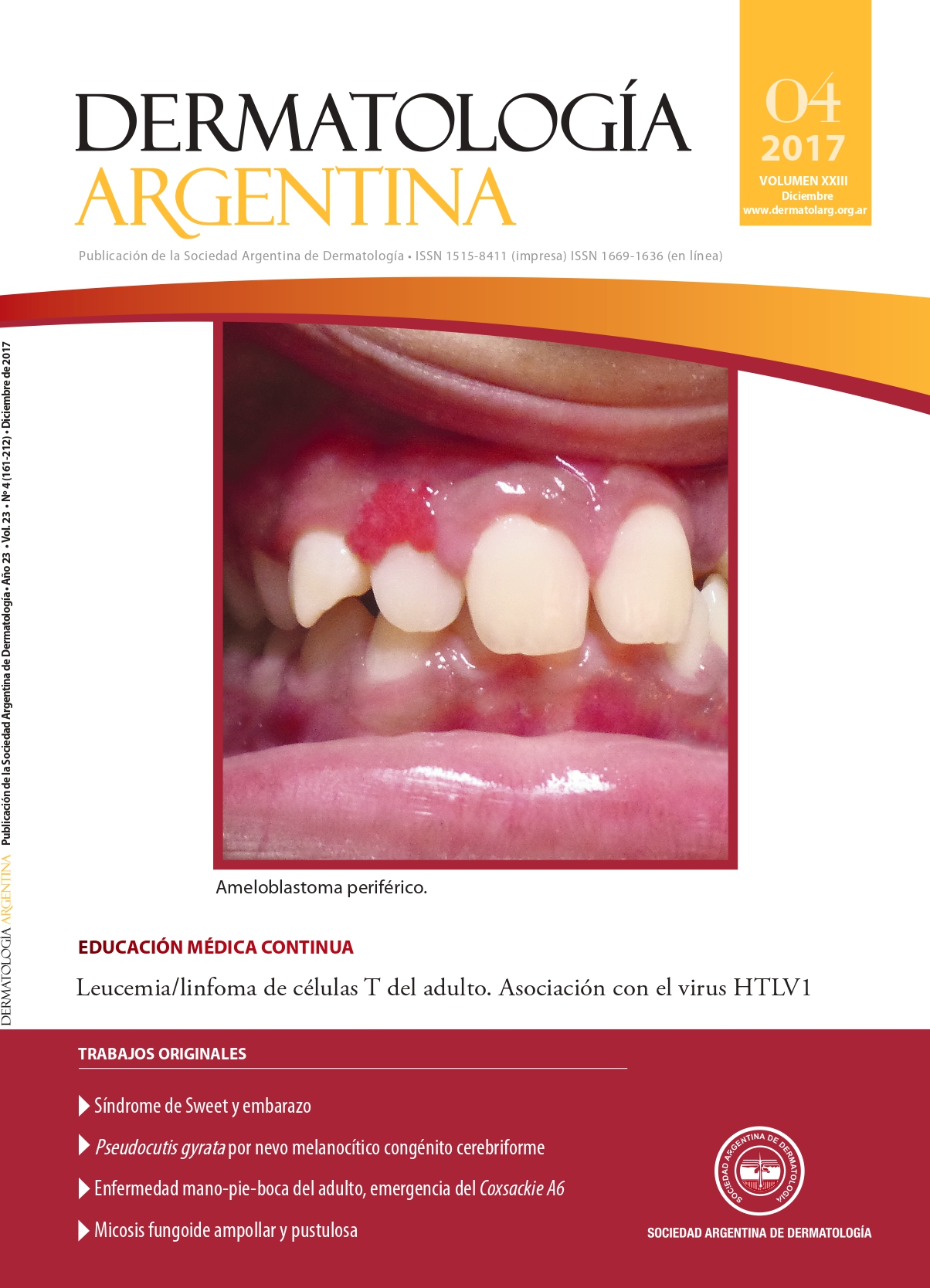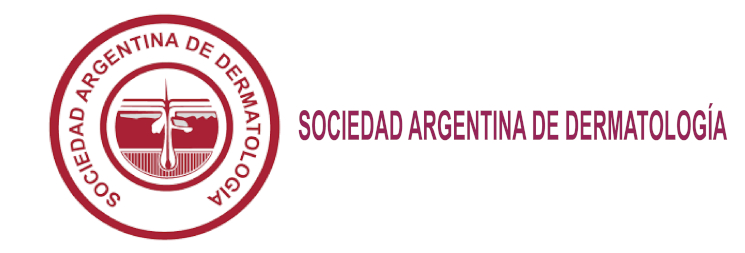Enfermedad mano-pie-boca del adulto, emergencia del Coxsackie A6
Palabras clave:
enfermedad mano-pie-boca en adultos, Coxsackie A6Resumen
La enfermedad mano-pie-boca es un exantema y enantema vesicular agudo, autorresolutivo, que afecta de preferencia a los niños, causado clásicamente por los virus Coxsackie A16 y Enterovirus 71. Es infrecuenteen los adultos. A partir de 2008 se han comunicado en el mundo brotes epidémicos de la enfermedad causados por otro virus: el Coxsackie A6. Este se caracteriza por manifestaciones cutáneas atípicas y un mayor porcentaje de enfermos adultos. Se presentan tres casos de la enfermedad mano-pie-boca causados por Coxsackie A6 en pacientes adultos sin antecedentes médicos relevantes. Se destaca el método de la reacción en cadena de la polimerasa con transcriptasa inversa (RT-PCR, por su sigla en inglés) para el diagnóstico específico de este serotipo de enterovirus.
Citas
I. Stanway G, Brown F, Christian P, Hovi T, et ál. The Positive Sense Single Stranded RNA Viruses - Picornaviridae, en Fauquet CM, Mayo M, Maniloff J, Desselberger U, et ál. Virus taxonomy: VIIIth report of the International Committee on Taxonomy of Viruses. London: Elsevier Academic Press; 2005: 757-760.
II. Ventarola D, Bordone L, Silverberg N. Update on hand-foot-and-mouth disease.Clin Dermatol 2015;33:340-346.
III. Larralde M, Aristizábal M. Enfermedad mano-pie-boca. Arch Ar-gent Dermatol 2005;55:25-29.
IV. Ramirez-Fort MK, Downing C, Doan HQ, Benoist F, et ál. Coxsac-kievirus A6 associated hand, foot and mouth disease in adults: clinical presentation and review of the literature. J Clin Virol2014;60:381-386.
V. Lott JP, Liu K, Landry ML, Nix WA, et ál. Atypical hand-foot-and-mouth disease associated with coxsackievirus A6 infection.J Am Acad Dermatol 2013;69:736-741.
VI. McIntyre MG, Stevens KM, Davidson S, Pippin T, et ál. Notes from the field: severe hand, foot, and mouth disease associated with coxsackievirus A6 Alabama, Connecticut, California, and Nevada, November 2011-February 2012. MMWR Morb Mortal Wkly Rep2012;61:213-214.
VII. Harris PNA, Wang AD, Yin M, Lee CK, et ál. Atypical hand, foot, and mouth disease: Eczema coxsackium can also occur in adults. Lan-cet Infect Dis 2014;14:1043.
VIII. Wang J, Cao Z, Zeng DD, Wang Q, et ál. Epidemiologic analysis, detection, and comparison of space-time patterns of Beijing hand-foot-mouth disease (2008-2012). [en línea], Public Li-brary of Science One, 24 de marzo de 2014; 9(3) https://doi.org/10.1371/journal.pone.0092745 [consultado 10 de junio de 2017].
IX. Solomon T, Lewthwaite P, Perera D, Cardosa MJ, et ál. Virology, epidemiology, pathogenesis, and control of enterovirus 71. Lan-cet Infect Dis 2010;10:778-790.
X. Delgado-Azañero W, Concha-Cusihuallpa H, Guevara-Canales JO. Infección de la mucosa oral por Coxsackie virus: enfermedad de boca-mano-pie. Rev Estomatol Herediana 2007;17:35-39.
XI. Akiyama K, Imazeki R, Yoshii F, Koide T, et ál. An adult case of hand, foot, and mouth disease caused by enterovirus 71 accompanied by opsoclonus myoclonica. Tokai J Exp Clin Med 2008;33:143-145.
XII. Galen WK. Cutaneous manifestations of enterovirus infections, en Tyring SK, Yen-Moore A, eds. Mucocutaneous manifestations of viral diseases. Marcel Dekker, New York, 2002:455-472.
XIII. Hayman R, Shepherd M, Tarring C, Best E, et ál. Outbreak of va-riant hand-foot-and-mouth disease caused by coxsackievirus A6 in Auckland, New Zealand. J Paediatr Child Health. 2014;50:751-755.
XIV. Zeng H, Lu J, Zheng H, Yi L, et ál. The epidemiological study of Coxsackievirus A6 revealing hand, foot and mouth disease epi-demic patterns in Guangdong, China. Sci Rep 2015;5:1-8.
XV. Chatproedprai S, Tempark T, Wanlapakorn N, Puenpa J, et ál. Unusual skin manifestation of hand, foot and mou-th disease associated with coxsackievirus A6: cases re-port. [en línea], Springer Plus, 17 de julio de 2015;4(32)362 https://doi.org/10.1186/s40064-015-1143-z [consultado 10 de junio de 2017].
XVI. Stewart CL, Chu EY, Introcaso CE, Schaffer A, et ál. Coxsackievi-rus A6–induced hand-foot-mouth disease. J Am Acad Dermatol 2013;149:1419-1421.
XVII. Sinclair C, Gaunt E, Simmonds P, Broomfield D, et ál. Atypical hand, foot, and mouth disease associated with Coxsackievirus A6 infection, Edinburgh, United Kingdom, January to February 2014. Euro Surveill 2014;19:1-5.
XVIII. Kaminska K, Martinetti G, Lucchini R, Kaya G, et ál. Coxsackievi-rus A6 and hand, foot and mouth disease: Three case reports of familial child-to-immunocompetent adult transmission and a literature review. Case Rep Dermatol. 2013;5:203-209.
XIX. Laga AC, Shroba SM, Hanna J. Atypical hand, foot and mouth disease in adults associated with coxsackievirus A6: a clinico-pa-thologic study. J Cutan Pathol 2016;43:940-945.
XX. Second J, Velter C, Cal S, Truchetet F, et ál.Clinicopathologic analysis of atypical hand, foot, and mouth disease in adult pa-tients. J Am Acad Dermatol 2016;16:1-8.
XXI. Mathes EF, Oza V, Frieden IJ, Cordoro KM, et ál. “Eczema coxsac-kium” and unusual cutaneous findings in an enterovirus out-break. Pediatrics 2013;132:149-157.
XXII. Leitch EC, Harvala H, Robertson I, Ubillos I, et ál. Direct identification of human enterovirus serotypes in cerebrospinal fluid by amplifica-tion and sequencing of the VP1 region. J Clin Virol 2009;44:119-124.
Descargas
Publicado
Número
Sección
Licencia
Derechos de autor 2017 Sociedad Argentina de Dermatología

Esta obra está bajo una licencia internacional Creative Commons Atribución-NoComercial-SinDerivadas 4.0.
El/los autor/es tranfieren todos los derechos de autor del manuscrito arriba mencionado a Dermatología Argentina en el caso de que el trabajo sea publicado. El/los autor/es declaran que el artículo es original, que no infringe ningún derecho de propiedad intelectual u otros derechos de terceros, que no se encuentra bajo consideración de otra revista y que no ha sido previamente publicado.
Le solicitamos haga click aquí para imprimir, firmar y enviar por correo postal la transferencia de los derechos de autor













